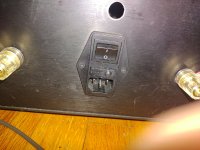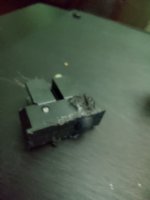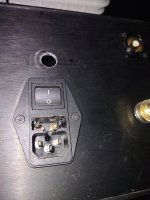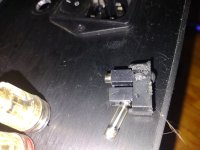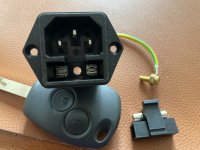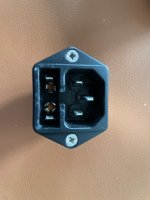This was an eye opener.....switched on M2 power amp clone, letting warm up a minute and noticed it had shut it self off. Noticed if Ioved cord, would come back on, then off again.
Pulled power cord out, took top off and started looking around shurter wiring. Tried to pull out fuse tray, and it was stuck. Finally getting it out, looked like solder melted out of one end of fuse, which broke off leaving one cap end of fuse stuck in drawer, which had obviously over heated a time or two!
Pulled power cord out, took top off and started looking around shurter wiring. Tried to pull out fuse tray, and it was stuck. Finally getting it out, looked like solder melted out of one end of fuse, which broke off leaving one cap end of fuse stuck in drawer, which had obviously over heated a time or two!
Attachments
So, decided to take drawer from AlephJ, but it was stuck also! Destroyed unit getting it out. Even worse! Checking BA3, all is fine, checked PoP, fine, F5m fine. How fuses were passing anything I don't know, but both these amps are run regularly
Original F5 using Neutrik power Con with no such foolishness. I don't know if I trust shurter any longer.
Anyone else having shurter meltdowns? These are all 4 amp slow blo fuses.
Russellc
Original F5 using Neutrik power Con with no such foolishness. I don't know if I trust shurter any longer.
Anyone else having shurter meltdowns? These are all 4 amp slow blo fuses.
Russellc
Attachments
Aleph J was running fine! Most worrisome. Are some of these shurter units heavier duty than others. These drawers should not be melting.
Russellc
Russellc
This is what comes with back panel kit from the store, clearly not enough. Both these amps, M2 and AlephJ have single power supply, (8) 33k uF and 500 VA transformer. Ran fine for years!
Most/many builds and build guides using this same shurter. I can't believe it got that hot to melt fuse and it didn't blow!
So order same size unit without fuses, or is it possible to jump past fuses and still use switch part and cord plug in of the shurter?
Quality fuse holders. I'm all ears, all I find, whether chassis mount for floor, back panel or inline are made of cheap plastic and beer can metal.
Would be nice if fuse section is jumpable so only switch used. Guess I need to remove it and mess with it a bit
Most/many builds and build guides using this same shurter. I can't believe it got that hot to melt fuse and it didn't blow!
So order same size unit without fuses, or is it possible to jump past fuses and still use switch part and cord plug in of the shurter?
Quality fuse holders. I'm all ears, all I find, whether chassis mount for floor, back panel or inline are made of cheap plastic and beer can metal.
Would be nice if fuse section is jumpable so only switch used. Guess I need to remove it and mess with it a bit
A 4 A fuse would allow 480 watts of (USA) power before tripping; this seems like the fuse is too large. The M2 is designed to provide 25 watts per channel, or 50 watts total. Even if the amplifier sheds another 50 watts, that would be a total of 100 watts, leading one to think a 1A slow-blow fuse would suffice. Perhaps there is something amiss inside that is conducting a great deal more electricity than is expected? Or the power switch is not designed to handle the power requirements of the amplifier.
In my M2x, I have a 2A fuse in the unswitched Shaffner FN9260 (rated for 6 amps/250V), and a H9KPXG for "soft start up". On further reflection, the 2A fuse was originally necessary because I didn't have the H9KPXG, and the initial current was too high for a 1.5A fuse, IIRC. I should try again, and see if it blows a 1A fuse.
Kind regards,
Drew
In my M2x, I have a 2A fuse in the unswitched Shaffner FN9260 (rated for 6 amps/250V), and a H9KPXG for "soft start up". On further reflection, the 2A fuse was originally necessary because I didn't have the H9KPXG, and the initial current was too high for a 1.5A fuse, IIRC. I should try again, and see if it blows a 1A fuse.
Kind regards,
Drew
The M2 power input spec is 160W continuous. A one amp fuse is not nearly enough.
So order same size unit without fuses,
that would be my choice, and mounting separate fuse case
What do you think happens to fuse holders if there is a poor contact causing resistance? 

This is quite a serious quality and safety issue. These are usually minimum 10A rated regardless of the application. It seems the construction is so that the fuse holders contacts do not make contact well enough or that the fuse generated heat can not be transferred to the environment well enough. This is usually the area of very cheap stuff not by the known brands.
* Can you tell what type/series and if it is a type with just 1 fuse and 1 spare fuse or a 2 fuse version (both in L and N)? I can not find it at the Schurter website except for the 6765 or 6762 that come close.
** It would be good to check what brand and type the 5 x 20 mm fuses are and to test a few of these. If only to exclude them being the cause.
Did you inform Schurter?
https://www.schurter.com/en/contact
* Can you tell what type/series and if it is a type with just 1 fuse and 1 spare fuse or a 2 fuse version (both in L and N)? I can not find it at the Schurter website except for the 6765 or 6762 that come close.
** It would be good to check what brand and type the 5 x 20 mm fuses are and to test a few of these. If only to exclude them being the cause.
Did you inform Schurter?
https://www.schurter.com/en/contact
Last edited:
These two amps have run for years! They both have 500 VA Antek transformers. Don't think that's it, BA3 runs a 1000 VA, older than these two, (run 10 years) fuse tray is perfect. As is XA252 and new built PoP amp. F5m fine, two 250 VA Avel Linberg transformersView attachment 1456916View attachment 1456916
Russellc
All of Nelson's amps use 2.5 slow fuses.
To melt the holder with 4 amps fuses sure seems like a lot of current??
Russellc
This is the unit that has come with the back panel kit from diy store. I haven't told schurter, if they don't know they should. It only seems to be two of my amps which have been running regularly for a few years.This is quite a serious quality and safety issue. These are usually minimum 10A rated regardless of the application. It seems the construction is so that the fuse holders contacts do not make contact well enough or that the fuse generated heat can not be transferred to the environment well enough. This is usually the area of very cheap stuff not by the known brands.
* Can you tell what type/series and if it is a type with just 1 fuse and 1 spare fuse or a 2 fuse version (both in L and N)? I can not find it at the Schurter website except for the 6765 or 6762 that come close.
** It would be good to check what brand and type the 5 x 20 mm fuses are and to test a few of these. If only to exclude them being the cause.
Did you inform Schurter?
https://www.schurter.com/en/contact
I wouldn't have noticed but the amp kept powering up or off wiggling the power cord.
Tried to remove fuse drawer and the surprise began.
I notice the new Deluxe series of chassis state the have a different cut out, and now the switch unit 10 amps (seems like higher might be better) with some kind of filter. Thinking I'm going back to power con from Neutrik along with separate "high quality" fuse holders, if they exist!
Russellc
The PEMs provided with the previous back panel parts kits are Schurter 4304.6090
https://www.mouser.com/datasheet/2/358/typ_6765-1275662.pdf
I see two things that may provide clues.
The fuse trays should make a satisfying click when inserted, but should not be 'difficult' to insert. They're a pain in the hindquarters to remove, IMO, but they should not be a challenge to insert.
This may not have been your specific situation, but it may benefit someone else. tl;dr - the fuse trays must be fully inserted. They'll "click" and the drawer will be flush or even slightly recessed with the surrounding area of the PEM.
Photos attached are of the same model PEM with 2A5 (live) and 10A (neutral) fuses used in service for over 1000 hours in a typical First Watt amplifier.


https://www.mouser.com/datasheet/2/358/typ_6765-1275662.pdf
I see two things that may provide clues.
- What appears to be discoloration / corrosion / material loss at the fuse contact points on both the live and neutral side. The contact points on all of mine are still nice / shiny copper at the center with no migration to the material on the edges.
- When I review the very first photo, the fuse tray is not fully inserted. That may not have been the situation under operation, but it is the situation shown in the photo.
The fuse trays should make a satisfying click when inserted, but should not be 'difficult' to insert. They're a pain in the hindquarters to remove, IMO, but they should not be a challenge to insert.
This may not have been your specific situation, but it may benefit someone else. tl;dr - the fuse trays must be fully inserted. They'll "click" and the drawer will be flush or even slightly recessed with the surrounding area of the PEM.
Photos attached are of the same model PEM with 2A5 (live) and 10A (neutral) fuses used in service for over 1000 hours in a typical First Watt amplifier.
The drawers, when checked first were all the way in. They had to be pried out! If you look closely you can see the nicks chipped out prying it out with screw driver.
Russellc
Russellc
^ Certainly a puzzler. I definitely don't want to discount your experience. We should all try our best to determine the most likely situation. At least anecdotally, there are 1000s of these PEMs in service without issue. So, I don't see cause for alarm, but it really would be nice to know what happened with yours.
FWIW moving forward, the way I remove my fuse drawers is a small tool (usually a screwdriver sitting nearby) inserted at the notch. Then it just pops out with a pull vs. a pry. You seem to have been prying around the edges.

FWIW moving forward, the way I remove my fuse drawers is a small tool (usually a screwdriver sitting nearby) inserted at the notch. Then it just pops out with a pull vs. a pry. You seem to have been prying around the edges.
There was another thread which may apply. I'd never thought about it, but made sense in the other thread. Fuses are small resistors, and so can get hot if they run close to their max current. I don't remember the details anymore beyond thinking I need to verify thermal on fuse holders in future projects. Another thought crossed my mind as well. Maybe it was a bad fuse batch and the resistance of the fuse was a bit higher running hotter than normal.
Why not?do not use those for A Class power amps; use separate heavy duty fuse holders/units/whatever proper name is
Still inform Schurter. It would not surprise me that the construction has a weakness with the contacts losing spring tension (if the fuse themselves have been excluded from defects). Especially when they flagged out production to a certain country or have more than one production facility.
My gut feeling says this is definitely not a user error but a design or (temporary) production weakness. The usual method of clamping the fuse is quite different at other brands. When they are circular they are usually quite deep so fully enclosing the complete fuse contact. See the pictures of both a low cost and of a Corcom one. Since yours are defective you could take one apart to check the circular contacts.
Both the fuses and fuse holders don't care if they are in a Pass device or an ice cream machine, they need to perform according specs. Simplest would be first testing and measuring the fuses also their physical dimensions. It these are thinner than normal ....
My gut feeling says this is definitely not a user error but a design or (temporary) production weakness. The usual method of clamping the fuse is quite different at other brands. When they are circular they are usually quite deep so fully enclosing the complete fuse contact. See the pictures of both a low cost and of a Corcom one. Since yours are defective you could take one apart to check the circular contacts.
Both the fuses and fuse holders don't care if they are in a Pass device or an ice cream machine, they need to perform according specs. Simplest would be first testing and measuring the fuses also their physical dimensions. It these are thinner than normal ....
Attachments
Last edited:
These were melted in place. Fuses were stuck, solder leaking out of caps! A couple broke and the end cap is stuck in the drawer. Only thing I can think of is the 4 amp fuse I used? I have put quite a few of them in service personally! All the other amps are fine.^ Certainly a puzzler. I definitely don't want to discount your experience. We should all try our best to determine the most likely situation. At least anecdotally, there are 1000s of these PEMs in service without issue. So, I don't see cause for alarm, but it really would be nice to know what happened with yours.
FWIW moving forward, the way I remove my fuse drawers is a small tool (usually a screwdriver sitting nearby) inserted at the notch. Then it just pops out with a pull vs. a pry. You seem to have been prying around the edges.
View attachment 1457139
BA3 has 1000 VA transformer. Lots of capacitance, 32 volt rails. It does use a diystore slow start device. It's device looks clean as a whistle. It has run for 10 years.Only the M2 and Aleph J amps had this issue.
I need to figure out a version that doesn't use fuses and fits the cut out. Then use separate fuse holders. And use 2.5 amp slow blo
Russellc
Last edited:
- Home
- Amplifiers
- Pass Labs
- Shurter on/off fuse units
